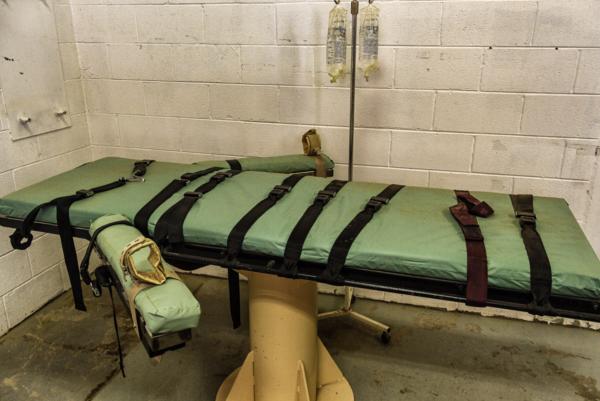
Regardless of your position on the death penalty, I believe that most of us would be horrified by the cruelty and incompetence in a recent case at an Alabama prison, regardless of any sympathy (or the lack thereof) one might have for a triple murderer.
A deeply disturbing story about how Alan Eugene Miller, who was sentenced to death after being convicted of multiple murders in 1999, is in the news again. This time it's because Miller sued the state of Alabama and won, reaching a court settlement guaranteeing that Miller would not be subjected to a second lethal injection after the prison botched the first in an awful way.
Miller's victory in court was based on his claim that he chose nitrogen hypoxia (more on this later), but prison officials "lost the paperwork" and proceeded to use lethal injection instead. His execution, like any other, was supposed to be carried out "humanely," but Miller's was anything but; he ended up being tortured instead.
The story of the botched attempt – not the only such failure by Alabama (1) – is horrific by any measure. It began with the inability of the prison staff to insert an IV needle – something that all healthcare workers are trained to do. But, as my colleague Dr. Chuck Dinerstein points out, it will be challenging, if not impossible, to find anyone in the medical field willing to participate in an execution (although there are some exceptions):
Much of the technical difficulty in executions has to do with finding and securely accessing a vein. This is training given to all surgical residents and most commonly now involves the use of ultrasound imaging to identify large veins that may be deep below the surface, like the femoral vein in the leg or the jugular vein in the neck. But there is no physician who will further medicalize execution by providing this service as it ethically violates the principle of doing no harm.
Dr. Chuck Dinerstein, medical director of ACSH
This probably explains why, according to the AP, Miller claimed that "[The] prison staff tried to find a vein; they poked him with needles for over an hour and at one point left him hanging vertically as he lay strapped to a gurney." Prison officials, who were forced to call off the execution, blamed Miller's obesity for the venipuncture problems, even though there are dozens of YouTube videos about this.
Instead, Miller will (presumably) be executed by nitrogen hypoxia, which, although permitted in Alabama, has never been used for execution in the US. Is this method more humane? This can be determined by examining documentation of suicide by asphyxia with inert gases, which has become increasingly common.
Suicide by helium inhalation has become increasingly common in the last few decades in Europe and the US because it produces a quick and painless death.
Cafora, et, al., Toxics 2022, 10(8), 424; https://doi.org/10.3390/toxics10080424
Nonetheless, given the technical difficulties in locating a vein and obtaining the "proper" medications, something I wrote about in 2017, inert gas asphyxiation, also legalized in Oklahoma and Mississippi, represents a substantial improvement over other forms of execution and will likely replace lethal injection. But if you're wondering why being "choked to death" is humane, that's a good question.
Hypoxia is not like choking
One reason that execution by inert gas is considered humane is that it spares the participant from the terribly unpleasant feeling of gasping for breath that one might experience from strangulation or using a plastic bag tied around the neck. This is because a lack of oxygen does not trigger the urge to breathe; it results from the body trying to expel the carbon dioxide it has retained. (This is also why you can't hold your breath for long periods.) Instead of choking, people breathing an inert gas like helium or nitrogen will not feel that they're being suffocated or strangled; they will continue to expel carbon dioxide but pass out and quickly die from lack of oxygen.
Helium vs. Nitrogen
Surprisingly, Cafora and colleagues failed to mention that suicide by helium is being rapidly replaced by nitrogen. Why? We are experiencing a worldwide helium shortage. Although this may sound like it will only affect birthday parties, liquid helium is essential for medical reasons, for example, cooling the MRI magnets. No helium, no MRI. This is one reason that when you buy a tank of helium to fill balloons, there is a good chance it will contain air. This is explained on Amazon, of all places (3).
Bottom line
Setting the ethics of capital punishment aside, if it needs to be done, it should be done humanely. In 2008 the Supreme Court ruled that lethal injection (using a 3-drug combination) does not constitute "cruel and unusual punishment." But there is considerable evidence that many lethal injections are anything but humane, especially when done improperly (4), which has resulted in suspensions of lethal injections in multiple states. Allen Eugene Miller may deserve to die, but neither Miller nor anyone else should be tortured in the process.
NOTES:
(1) Alabama has had the same problem three other times since 2018.
(2) To perform executions, prisons typically train a staff member in venipuncture.
(3) Dr. Dinerstein adds that 20% oxygen is added to nitrous oxide to prevent accidental deaths from anesthesia. Similarly, even when helium balloons contain 20% air they will still float.
(4) Many botched legal injections can be blamed on the inability of prisons to obtain the three drugs permitted by Supreme Court in 2008. As a result, prisons are using untested substitutes, for example, the simple sedative versed in place of sodium thiopental, an anesthetic. But sodium thiopental is made in Europe, where the death penalty is almost universally rejected. They no longer ship it or other drugs that could be used for lethal injections to US prisons.



